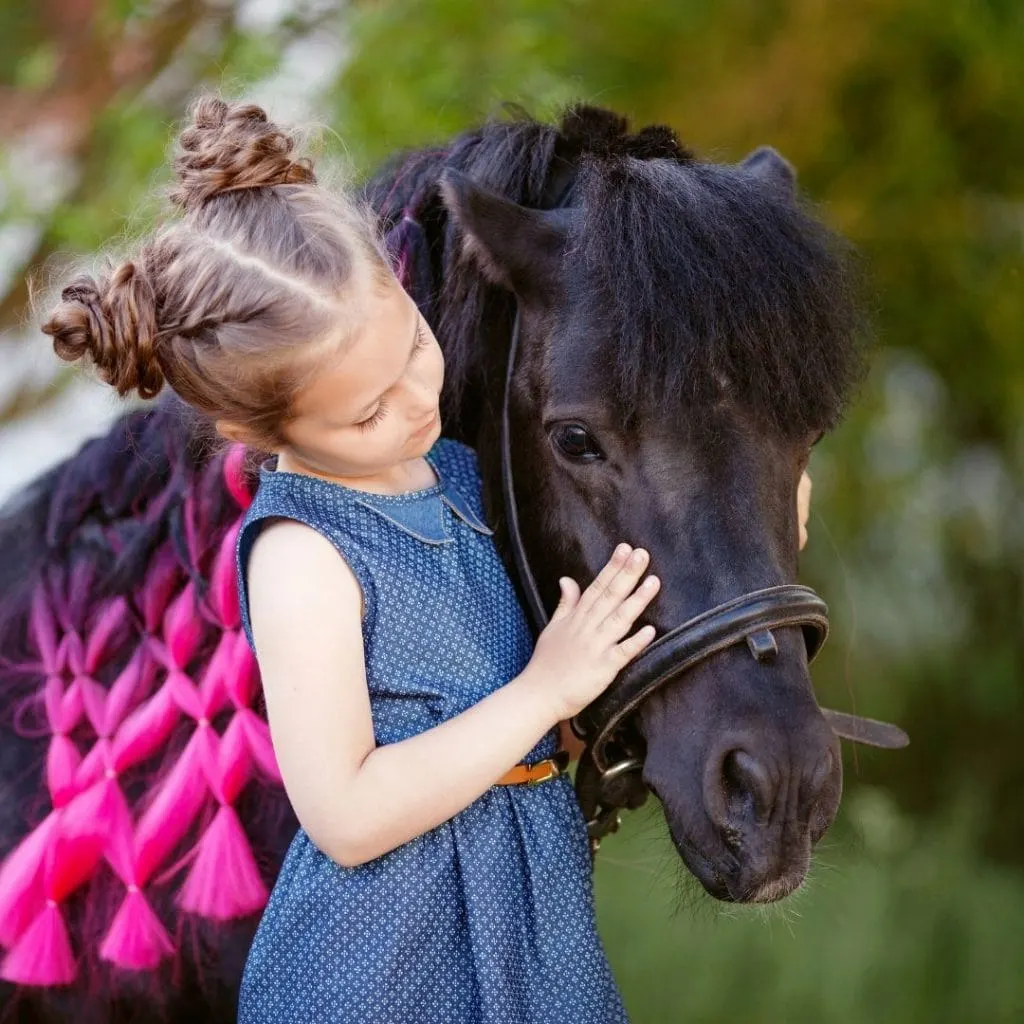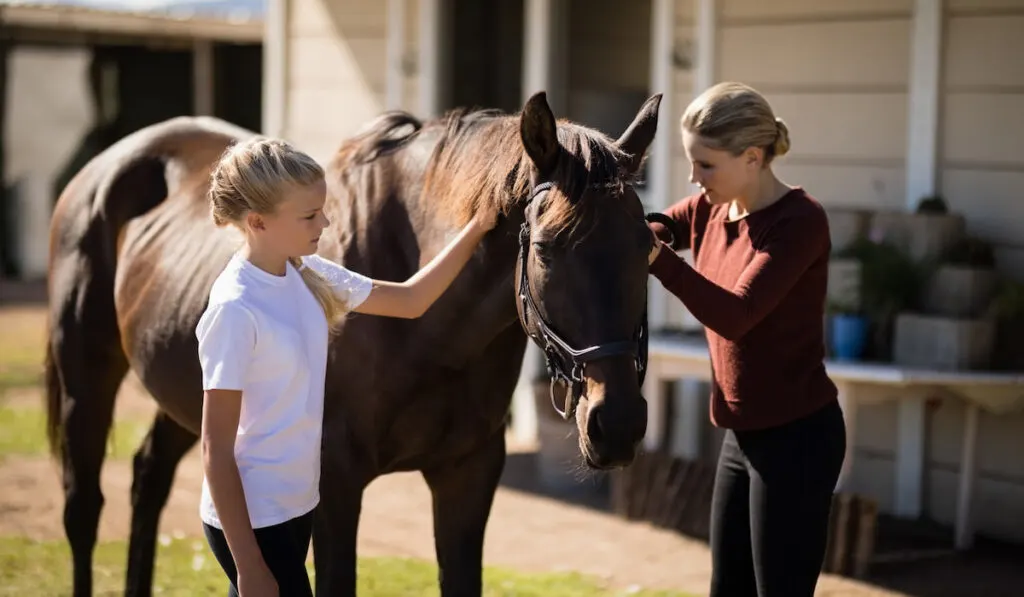Horses are big animals, some more so than others, but they are so soft, fluffy and friendly it is only natural to want to pet them. The great thing is, most horses actually love when humans pet them. They will stand quietly for hours as you run your fingers over their soft hair. But what is the right way to pet a horse? Let’s go over the steps you should take.

Just a reminder: These tips work for any domestic equine including horses, ponies, donkeys, mules and burros.
Table of Contents
1. Ask Permission
If you are visiting a farm with horses you should always ask permission before petting the horses. There are sometimes reasons why certain horses shouldn’t be pet.
If you were to pet a sick horse, for example, and then also pet a healthy horse, that could cause the healthy horse to get sick. Diseases and viruses that we may not notice can be transferred from horse to horse just by petting.
Some horses are wilder than others and shouldn’t be pet. Young horses, for example, might have a tendency to want to nip or bite. Some stallions are nippy or even aggressive as well.
If the owner says yes, feel free to ask where his or her horse likes to be pet. If they say no, it is usually for a reason. You might want to ask if there is a different horse you can pet instead.
2. Don’t Sneak up on a Horse
Most horses will walk up and allow you to pet them. If the horse doesn’t notice you or you have to walk to the horse, you want to make sure to do that in a way that won’t scare the horse.
Always try to approach the horse from the head or shoulder. If the horse has his butt facing toward you, walk in a big arc so that you are heading toward his head or shoulder and not his butt.
Horse’s can’t see very well behind them and you definitely don’t want to scare him and make him run or even kick.

3. Where to Pet the Horse
Hopefully, you took my advice and asked the horse’s owner where the horse likes to be pet. If they let you know, it is OK to start wherever the owner tells you.
If the owner didn’t say anything or you forgot to ask, the best place to start is the horse’s neck or shoulder. This is usually the favorite spot for most horses and the least likely spot for them to bite or kick if they get irritated. This is called the safe zone.
Another good spot is the back and the cheeks and forehead. Be sure to stay away from the sensitive areas of the horse like the eyes, ears, muzzle, and belly of the horse. While some horses might be OK with you petting these areas, many are sensitive and won’t like to be touched there.
There are a few areas you want to stay away from unless the owner specifically tells you it’s OK. That is the tail, legs, flank, and belly of the horse. These areas are particularly sensitive to most horses and they usually don’t like strangers touching them in these places. These areas are most likely to cause a horse to stomp his foot or kick out at you.
I made this diagram to help show you the places you can pet a horse.

3. How to Pet the Horse
Now that we know where we should pet the horse, let’s cover how to do it.
You will want to lay your hand flat and pet your horse with the whole palm of your hand. Use gentle, long strokes. If you are petting the neck and the shoulder you can start as high as you want on the neck and make a nice, long stroke all the way down.
When you pet the horse you want to do it gently. Don’t “pat” the horse like you might a dog. Instead, pet the horse like you would pet a rabbit or cat.
Tips for Staying Safe When Petting Horses
Never Pet a Mustang in the Wild.
Mustangs in the wild may seem friendly. They may even walk up to you all by themselves. You should never pet a mustang in the wild. In some places, it is even illegal to pet horses in the wild. If you come across a mustang with an owner, though, you don’t have to worry. Just ask the owner for permission. Once a mustang has been trained they are usually very gentle and friendly.
Never Walk Behind the Horse.

A horse can’t see things that are walking directly behind it. When you walk behind a horse it may not see you and, when it realizes you are there, it may get scared and kick you. A horse kick can be very dangerous, in fact, I wrote a whole article about the dangers of horse kicks!
Never Go Under the Horse.
When you walk in front of the horse, don’t go under their necks. NEVER go under the belly. When you go under a horse they can’t see you. They could spook and run you over, kick you or worse. Instead, make a wide circle in front of them to walk around.
Be Careful With the Muzzle
If you do pet the muzzle (mouth), be very careful, horses can bite. Some horses might think your fingers are carrots. If you have ever seen how big a horse’s teeth are, you know you definitely don’t want to be bitten. This is also one of the reasons I say to ask the owner for permission to pet a horse, just in case the horse is known to be “mouthy” or very playful with putting things in its mouth.

Get Permission Before Feeding Treats
Don’t feed the horse any treats unless you have permission. Not all treats are safe for horses. Some horses have medical conditions where they can’t eat horse treats that are safe for most horses. Some horses shouldn’t have carrots, for example. While these conditions are not very common, it’s best to ask for permission before feeding a horse any treats.
Don’t Be Too Rowdy
Try to stay quiet around the horse. Some horses get scared more easily than others. Jumping, playing and fast movements can make a horse scared and might cause him to spook.
Let the Horse Walk Away If He Wants
Pay attention to the horse’s body language. If he starts leaning away from you or walking away, that probably means he doesn’t want to be pet anymore. Don’t chase him. It doesn’t mean he doesn’t like you. It could just be as simple as he has all of the pets and love he wanted right then.
Final Thoughts
Petting horses is usually enjoyable for both the horse and the human. Be sure to ask permission from the horse’s owner before petting a horse. The safety tips above will help to keep you safe but always use caution and have an adult with you whenever you are around a horse.
Related Posts
- 15 Fruits and Vegetables Horse’s Love to Eat
- How to Clean Horse Water Buckets
- Mustang Horse Colors w/Pictures


